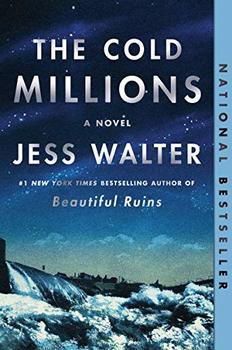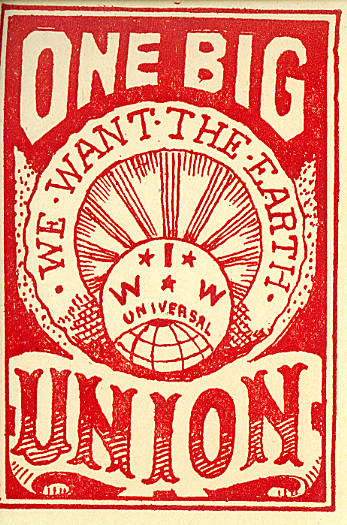Summary | Excerpt | Reading Guide | Reviews | Beyond the Book | Read-Alikes | Genres & Themes | Author Bio

Critics' Opinion:
Readers' Opinion:
First Published:
Oct 2020, 352 pages
Paperback:
Sep 2021, 352 pages
 Book Reviewed by:
Book Reviewed by:
Kim Kovacs
Buy This Book
This article relates to The Cold Millions
 The plot of Jess Walter's novel, The Cold Millions, revolves around the actions of the newly-formed Industrial Workers of the World (IWW) in Spokane, Washington in 1909.
The plot of Jess Walter's novel, The Cold Millions, revolves around the actions of the newly-formed Industrial Workers of the World (IWW) in Spokane, Washington in 1909.
The groundwork for the IWW was laid by the American Federation of Labor (AFL), a union formed in Columbus, Ohio in 1886. That organization's purpose was to ensure employers provided a safe environment for their workers, that businesses compensated union members for on-the-job injuries, and that they paid their workers an adequate wage. Formed as an umbrella group for other smaller unions, the AFL initially allowed pretty much anyone to join. Within a decade, however, it coalesced around organizations that mostly supported craft unions (carpenters, blacksmiths, masons, etc.), and their membership was predominantly comprised of white men.
The principles of socialism were circulating in the United States around the turn of the century, and many of the AFL's membership began to feel the group's acceptance of capitalism and its exclusion of trade workers was unacceptable. Six prominent AFL members met in Chicago in 1904 to discuss their options. They decided to break with their organization and form a new one, which they'd call the Industrial Workers of the World. In June, 1905, a convention of 200 socialists and trade unionists met and officially created the IWW. Led by miner William Haywood, this initial meeting was attended by many of the day's most famous labor and socialist activists, including Eugene Debs and Mary Harris "Mother" Jones.
The IWW — whose members are known as "Wobblies" — was the first union to literally accept all who requested membership, including non-whites, immigrants, unskilled workers and women. Based heavily on the principles of Marxism, the IWW was intended to be "one big union" that would unite workers in a common cause.
It truly was a remarkable force for marginalized workers. Dues were deliberately kept very low so as to allow poorer workers to join, and immigrants with a paid-up union card from another country were immediately eligible for membership in the IWW. Women not only joined the group; some had leadership roles. Elizabeth Gurley Flynn, who features prominently in The Cold Millions, was an organizer of men (something unheard of at the time) – and she wasn't the only one. Furthermore, according to an essay by historian Joyce Kornbluh, "Thousands of Spanish-speaking workers on the East Coast who had been denied AFL membership on the basis of their ethnic background became the backbone of the IWW mariners' unions."
The IWW's membership policies weren't the only radical part of the group's mission. The preamble to its constitution states in part:
The working class and the employing class have nothing in common. There can be no peace so long as hunger and want are found among millions of the working people and the few, who make up the employing class, have all the good things of life.
Between these two classes a struggle must go on until the workers of the world organize as a class, take possession of the means of production, abolish the wage system, and live in harmony with the earth.
It is the historic mission of the working class to do away with capitalism. The army of production must be organized, not only for everyday struggle with capitalists, but also to carry on production when capitalism shall have been overthrown. By organizing industrially we are forming the structure of the new society within the shell of the old.
From its inception, the IWW had two competing philosophies: socialism and anarchism. The socialists wanted to focus on change through the established political system (i.e., voting for candidates that supported socialist positions). The anarchists, on the other hand, advocated actions such as strikes, mass demonstrations and sabotage, tactics which often led to arrests, beatings and killings — as well as lots of publicity, which was partly the point. The group — its anarchist wing in particular — was especially active in the Pacific Northwest's mining and timber industries.
IWW membership reached its peak in 1917, with over 150,000 people enrolled internationally. It was the only union that opposed the United States' entry into World War I, and its members actively tried to disrupt the war effort by slowing down copper production. This led to arrests under the newly-enacted Espionage Act of 1917 and Sedition Act of 1918. The latter made it a federal offense to use "disloyal, profane, scurrilous, or abusive language" about the Constitution, the government, the American uniform, or the flag. The government prosecuted over 2,100 people under these acts. (Interestingly, the 1917 Espionage Act is still in force and was used to indict Wikileaks founder Julian Assange in 2019.)
Membership in the IWW waned significantly as a result of these legal issues. The union fared no better during the subsequent years, as public opinion turned against socialism and conflict arose among the group's leadership. The IWW never folded, however, and currently claims over 9,000 members. It's recently been active in organizing protection for workers during the COVID-19 pandemic.
IWW flyer, courtesy of University of Washington Libraries
Filed under People, Eras & Events
![]() This "beyond the book article" relates to The Cold Millions. It originally ran in October 2020 and has been updated for the
September 2021 paperback edition.
Go to magazine.
This "beyond the book article" relates to The Cold Millions. It originally ran in October 2020 and has been updated for the
September 2021 paperback edition.
Go to magazine.





The House on Biscayne Bay
by Chanel Cleeton
As death stalks a gothic mansion in Miami, the lives of two women intertwine as the past and present collide.

The Flower Sisters
by Michelle Collins Anderson
From the new Fannie Flagg of the Ozarks, a richly-woven story of family, forgiveness, and reinvention.

The Funeral Cryer by Wenyan Lu
Debut novelist Wenyan Lu brings us this witty yet profound story about one woman's midlife reawakening in contemporary rural China.
Your guide toexceptional books
BookBrowse seeks out and recommends the best in contemporary fiction and nonfiction—books that not only engage and entertain but also deepen our understanding of ourselves and the world around us.